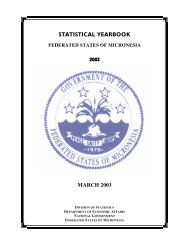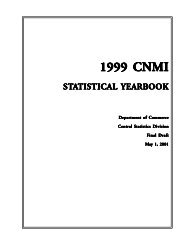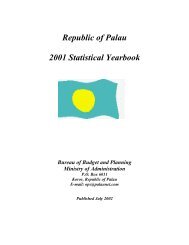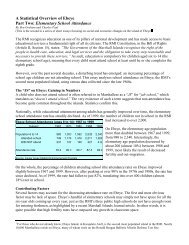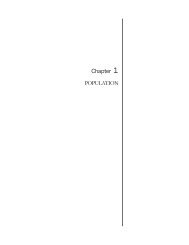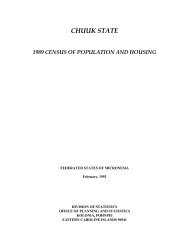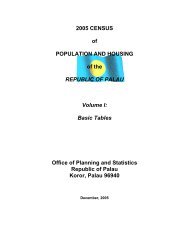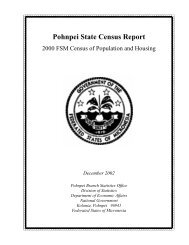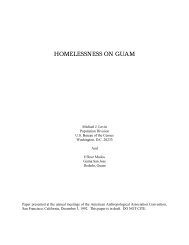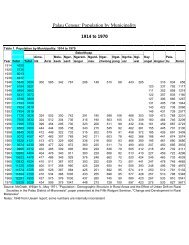Chapter 1. Introduction2000 FSM <strong>Census</strong> of <strong>Chuuk</strong> <strong>State</strong>Japanese values. This policy continued even after naval rule was replaced by civilian administration in July 1921 andthe headquarters transferred from <strong>Chuuk</strong> to Palau.Through the 1920s the administration continued its emphasis on education, particularly on the study of the Japaneselanguage. Better students who completed the first three years of school were sent to a higher school on Tonoas for anadditional two years. A few of the <strong>Chuuk</strong>ese graduates were employed as policemen or teachers' aides; others went towork for the government as errand boys or clerks. A number of others found employment with Nambo, the greatJapanese trading company of the day that had stores on several islands and ran coconut plantations in various sites.Still others signed on to work in the phosphate mines on Angaur. Youth <strong>org</strong>anizations, or Seinandan, flourished onnearly all the islands.The 1930s saw the first large-scale immigration of Japanese colonists into <strong>Chuuk</strong>. Okinawan settlers came in evergreaternumbers and, aided by government subsidies, bought fishing vessels and produced Katsuobushi for local useand export. Later immigrants obtained land grants from the government to set up vegetable and sweet potato gardens,and some expanded into the production of starch. Much of the land that had originally been claimed by the governmentwas made available to Japanese businesses for development purposes. By 1937 nearly 4000 Japanese and Okinawanslived in <strong>Chuuk</strong> out of a total population numbering 18,000. In these golden years of development, subsidies wereended. The Japanese government had turned Micronesia into a colony that paid its own way. <strong>Chuuk</strong>ese participationin this prosperity was real but marginal. The fishing industry, like most of the major industries, was run entirely byJapanese nationals, but hundreds of <strong>Chuuk</strong>ese men went to Pohnpei to do plantation labor on a contract basis. Localpeople bought steamship tickets to other parts of Micronesia and bicycles for their children. Never before had therebeen so much money in circulation among the <strong>Chuuk</strong>ese.The war brought a reversal of fortune to Japanese and <strong>Chuuk</strong>ese alike. For two years before Pearl Harbor the Japanesewere busy constructing airfields and port facilities, but it was only in January 1944, on the eve of the threatened Alliedinvasion, that the Japanese Army defense forces arrived and serious work began on the caves and tunnels and gunemplacements that are still tourist attractions today. The invasion never came, but enemy bombers following theUnited <strong>State</strong>s carrier raid on the island group in February 1944 regularly pounded <strong>Chuuk</strong>. For the last year and a halfof the war, some 35,000 Japanese fighting men and laborers shared the islands' scant food resources with the localpopulation. Every available foot of land was planted in sweet potatoes, and <strong>Chuuk</strong>ese often had to sneak food out oftheir own gardens to feed themselves and their families. All this ended on August 15, 1945, when the JapaneseEmperor announced his country's unconditional surrender to the Allies.Table 1.2 shows the population of <strong>Chuuk</strong>ese and Japanese during the Japanese period. At the beginning of the period,of course, few Japanese were in the Islands. As the Japanese Administration increased its influence in the islands, thenumber and percentage of Japanese increased considerably until the end of World War II (when the Japanese wererepatriated.)Japan intended to annex the islands. Many Okinawans and Koreans left Japan for the larger Pacific Islands, and manybrought their families. Although the total effect on Japan's population was minor, the intent was to use the islands torelieve population pressure in Japan itself. By December, 1941, when Japan bombed Pearl Harbor, immigrants inMicronesia outnumbered locals on some islands from 3 or 4 to 1 and other islands by as much as 10 or more to 1(Bowden et al., 1966:27). Also, they began to "Japanize the islanders through education, propaganda, intermarriage,and in general the promotion of cultural changes" (Mirrer 1971:23). As a subsequent change, intermarriage and affairsbrought increased numbers of inter-racial babies.Japanese constituted less than 6 percent of the population in 1920, and only 3 percent in 1925. Japanese continued to bea fairly small percentage of the population in the 1930 and 1935 censuses, although they were 16 percent of thepopulation by 1935 -- about 1 in every 6 persons. Unfortunately we do not have information from the 1940 census,because it is obvious that an enormous build up occurred in the pre-war period.By 1911, the native population of what was to become <strong>Chuuk</strong> state had decreased to 11,000 and by 1920 to 9,822. Theestablishment of a health service stopped the downward trend, and the population increased very slightly from 9,822 in1920 to 10,344 in 1935 (See Table 1.2). Table 1.2 also shows the number of Japanese in <strong>Chuuk</strong> during the Japaneseperiod. The Japanese took censuses in 1920, 1925, 1930, 1935, and 1940. Complete, lengthy reports were prepared for6 <strong>Chuuk</strong> Branch Statistics Office, Division of Statistics, FSM Department of Economic Affairs
2000 FSM <strong>Census</strong> of <strong>Chuuk</strong> <strong>State</strong>Chapter 1. Introductionthe 1930 and the 1935 censuses. The 1930 <strong>Census</strong> report included comparative information for the 1920 and 1925<strong>Census</strong>es. The 1940 <strong>Census</strong> seems to have been collected and tabulated, but no publication is in current circulation.Table 1.2. Population of Japanese and <strong>Chuuk</strong>ese in <strong>Chuuk</strong>: 1920 to 1946NumbersPercentDate Total Natives Japanese Total Natives Japanese1920 10,411 9,822 589 100.0 94.3 5.71925 10,171 9,834 337 100.0 96.7 3.31930 10,888 10,153 735 100.0 93.2 6.81935 12,322 10,344 1,978 100.0 83.9 16.11940 NA 14,734 NA ... ... ...1945 (Dec) 45,854 8,520 37,334 100.0 18.6 81.41946 (Aug.) 10,485 9,185 1,300 100.0 87.6 12.4Source: Hall and Pelzer, 1946:7Notes: While earlier figures include only the islands of <strong>Chuuk</strong>, the figures for 1940 gives the population of Greater <strong>Chuuk</strong>. The Japanese estimated the population ofthe islands around <strong>Chuuk</strong> at approximately 5,000.Immediately after the World War II, the <strong>Chuuk</strong> population dropped maybe because of the repatriation of the Japanese.During the subsequent years, the population gradually increased until it doubled in 1971 (about 50 years later). Afteranother 3 decades, the <strong>Chuuk</strong> population tripled.Table 1.3 Population of <strong>Chuuk</strong>: 1920 to 2000Year Population Source1920 14,788 Nan’yo-cho 19371925 14,961 Nan’yo-cho 19371930 15,200 Nan’yo-cho 19371935 15,129 Nan’yo-cho 19371940 14,736 Hall and Pelzer, 1946:1946 9,185 Hall and Pelzer, 1946:1949 14,936 U.S. Department of the Navy 19491950 15,617 U.S. Department of the Navy 19501951 15,788 U.S. Department of the Navy 19511952 15,848 U.S. Department of Interior 19521954 16,946 U.S. Department of <strong>State</strong> 19551956 17,477 U.S. Department of <strong>State</strong> 19571957 18,605 U.S. Department of <strong>State</strong> 19581958 20,124 Office of the High Commissioner, TTPI 19591959 21,010 U.S. Department of <strong>State</strong> 19601960 21,401 U.S. Department of <strong>State</strong> 19611961 21,309 U.S. Department of <strong>State</strong> 19621963 22,564 U.S. Department of <strong>State</strong> 19631964 23,344 U.S. Department of <strong>State</strong> 19641965 24,521 U.S. Department of <strong>State</strong> 19651966 25,820 U.S. Department of <strong>State</strong> 19661967 25,107 School of Public Health, Univ. of Hawaii n.d.1968 26,368 U.S. Department of <strong>State</strong> 19691969 27,453 U.S. Department of <strong>State</strong> 19701971 29,334 U.S. Department of <strong>State</strong> 19721972 32,732 U.S. Department of <strong>State</strong> 19731973 31,596 Office of the <strong>Census</strong> Coordinator, TTPI 19751975 33,040 U.S. Department of <strong>State</strong> 19761976 34,120 U.S. Department of <strong>State</strong> 19771977 35,220 U.S. Department of <strong>State</strong> 19781978 36,350 U.S. Department of <strong>State</strong> 19791979 37,400 U.S. Department of <strong>State</strong> 19801980 37,488 U.S. Bureau of the <strong>Census</strong> 1982a1984 44,596 U.S. Department of <strong>State</strong> 19851989 47,871 Office of Planning and Statistics, FSM 19921994 53,319 1994 FSM <strong>Census</strong> of Population and Housing, 19962000 53,595 2000 FSM <strong>Census</strong> of Population and Housing,Sources: 1989 <strong>Chuuk</strong> <strong>State</strong> <strong>Census</strong> <strong>Report</strong> Table 1.3; L.J. Gorenflo, 1995.The population of <strong>Chuuk</strong> increased by 253 percent between 1930 and 2000. The level of increase varied by regions.The least increase was in the Mortlocks (about 103 percent), and the highest in the Northern Namoneas, over 500percent (Table 1.4). This trend suggested out-migration from the Outer Islands to the Lagoon, as a result of limitedland area in the Outer Islands and better economic and social (school facilities, etc) conditions in the Lagoon.<strong>Chuuk</strong> Branch Statistics Office, Division of Statistics, FSM Department of Economic Affairs 7
- Page 5: iii
- Page 12 and 13: Preface2000 FSM Census of Chuukx
- Page 14 and 15: Table of contents2000 FSM Census of
- Page 16 and 17: LIST OF TEXT TABLESTABLEPageChapter
- Page 18 and 19: List of Text Table2000 FSM Census o
- Page 20 and 21: LIST OF FIGURESFIGUREPageFigure 1.1
- Page 22 and 23: List of Basic-Tables2000 FSM Census
- Page 24 and 25: MAP OF FSMxxiiChuuk Branch Statisti
- Page 27 and 28: 2000 FSM Census of Chuuk StateExecu
- Page 29 and 30: CHAPTER 1INTRODUCTIONThe creation o
- Page 31 and 32: 2000 FSM Census of Chuuk StateChapt
- Page 33: 2000 FSM Census of Chuuk StateChapt
- Page 37 and 38: 2000 FSM Census of Chuuk StateChapt
- Page 39 and 40: 2000 FSM Census of Chuuk StateChapt
- Page 41 and 42: 2000 FSM Census of Chuuk StateChapt
- Page 43 and 44: 2000 FSM Census of Chuuk State Chap
- Page 45: 2000 FSM Census of Chuuk StateChapt
- Page 48 and 49: Chapter 2. Age and Sex Structure200
- Page 50 and 51: Chapter 2. Age and Sex Structure200
- Page 52 and 53: Chapter 2. Age and Sex Structure200
- Page 55 and 56: CHAPTER 3HOUSEHOLDS, FAMILIES, AND
- Page 57 and 58: 2000 FSM Census of Chuuk StateChapt
- Page 59 and 60: 2000 FSM Census of Chuuk StateChapt
- Page 61: 2000 FSM Census of Chuuk StateChapt
- Page 64 and 65: Chapter 4. Fertility2000 FSM Census
- Page 66 and 67: Chapter 4. Fertility2000 FSM Census
- Page 68 and 69: Chapter 4. Fertility2000 FSM Census
- Page 71 and 72: CHAPTER 5MORTALITYIntroductionAs re
- Page 73 and 74: 2000 FSM Census of Chuuk StateChapt
- Page 75: 2000 FSM Census of Chuuk StateChapt
- Page 78 and 79: Chapter 6. Migration2000 FSM Census
- Page 80 and 81: Chapter 6. Migration2000 FSM Census
- Page 82 and 83: Chapter 6. Migration2000 FSM Census
- Page 84 and 85:
Chapter 6. Migration2000 FSM Census
- Page 86 and 87:
Chapter 7. Religion, Ethnicity, and
- Page 88 and 89:
Chapter 7. Religion, Ethnicity, and
- Page 90 and 91:
Chapter 7. Religion, Ethnicity, and
- Page 92 and 93:
Chapter 8. Education2000 FSM Census
- Page 94 and 95:
Chapter 8. Education2000 FSM Census
- Page 96 and 97:
Chapter 8. Education2000 FSM Census
- Page 98 and 99:
Chapter 8. Education2000 FSM Census
- Page 100 and 101:
Chapter 8. Education2000 FSM Census
- Page 103 and 104:
CHAPTER 9ECONOMIC ACTIVITYIntroduct
- Page 105 and 106:
2000 FSM Census of Chuuk StateChapt
- Page 107 and 108:
2000 FSM Census of Chuuk StateChapt
- Page 109 and 110:
2000 FSM Census of Chuuk StateChapt
- Page 111 and 112:
2000 FSM Census of Chuuk StateChapt
- Page 113 and 114:
2000 FSM Census of Chuuk StateChapt
- Page 115 and 116:
2000 FSM Census of Chuuk StateChapt
- Page 117 and 118:
CHAPTER 10INDUSTRY AND OCCUPATIONIn
- Page 119 and 120:
2000 FSM Census of Chuuk StateChapt
- Page 121 and 122:
2000 FSM Census of Chuuk StateChapt
- Page 123 and 124:
2000 FSM Census of Chuuk StateChapt
- Page 125 and 126:
2000 FSM Census of Chuuk StateChapt
- Page 127 and 128:
2000 FSM Census of Chuuk StateChapt
- Page 129 and 130:
CHAPTER 11INCOMEIntroductionThe 200
- Page 131 and 132:
2000 FSM Census of Chuuk StateChapt
- Page 133 and 134:
2000 FSM Census of Chuuk StateChapt
- Page 135 and 136:
2000 FSM Census of Chuuk StateChapt
- Page 137:
2000 FSM Census of Chuuk StateChapt
- Page 140 and 141:
Chapter 12. Housing2000 FSM Census
- Page 142 and 143:
Chapter 12. Housing2000 FSM Census
- Page 144 and 145:
Chapter 12. Housing2000 FSM Census
- Page 146 and 147:
Chapter 12. Housing2000 FSM Census
- Page 148 and 149:
Chapter 12. Housing2000 FSM Census
- Page 150 and 151:
Chapter 12. Housing2000 FSM Census
- Page 152 and 153:
Chapter 12. Housing2000 FSM Census
- Page 154:
Chapter 12. Housing2000 FSM Census
- Page 157 and 158:
BIBLIOGRAPHYArriaga, E.E., (1983).
- Page 159:
2000 FSM Census of Chuuk StateBibli
- Page 162 and 163:
Basic Tables2000 FSM Census of Chuu
- Page 164 and 165:
Basic Tables2000 FSM Census of Chuu
- Page 166 and 167:
Basic Tables2000 FSM Census of Chuu
- Page 168 and 169:
Basic Tables2000 FSM Census of Chuu
- Page 170 and 171:
Basic Tables2000 FSM Census of Chuu
- Page 172 and 173:
Basic Tables2000 FSM Census of Chuu
- Page 174 and 175:
Basic Tables2000 FSM Census of Chuu
- Page 176 and 177:
Basic Tables2000 FSM Census of Chuu
- Page 178 and 179:
Basic Tables2000 FSM Census of Chuu
- Page 180 and 181:
Basic Tables2000 FSM Census of Chuu
- Page 182 and 183:
Basic Tables2000 FSM Census of Chuu
- Page 184 and 185:
Basic Tables2000 FSM Census of Chuu
- Page 186 and 187:
Basic Tables2000 FSM Census of Chuu
- Page 188 and 189:
Basic Tables2000 FSM Census of Chuu
- Page 190 and 191:
Basic Tables2000 FSM Census of Chuu
- Page 192 and 193:
Basic Tables2000 FSM Census of Chuu
- Page 194 and 195:
Basic Tables2000 FSM Census of Chuu
- Page 196 and 197:
Basic Tables2000 FSM Census of Chuu
- Page 198 and 199:
Basic Tables2000 FSM Census of Chuu
- Page 200 and 201:
Basic Tables2000 FSM Census of Chuu
- Page 202 and 203:
Basic Tables2000 FSM Census of Chuu
- Page 204 and 205:
Basic Tables2000 FSM Census of Chuu
- Page 206 and 207:
Basic Tables2000 FSM Census of Chuu
- Page 208 and 209:
Basic Tables2000 FSM Census of Chuu
- Page 210 and 211:
Basic Tables2000 FSM Census of Chuu
- Page 212 and 213:
Basic Tables2000 FSM Census of Chuu
- Page 214 and 215:
Basic Tables2000 FSM Census of Chuu
- Page 216 and 217:
Basic Tables2000 FSM Census of Chuu
- Page 218 and 219:
Basic Tables2000 FSM Census of Chuu
- Page 220 and 221:
Basic Tables2000 FSM Census of Chuu
- Page 222 and 223:
Basic Tables2000 FSM Census of Chuu
- Page 224 and 225:
Basic Tables2000 FSM Census of Chuu
- Page 226 and 227:
Basic Tables2000 FSM Census of Chuu
- Page 228 and 229:
Basic Tables2000 FSM Census of Chuu
- Page 230 and 231:
Basic Tables2000 FSM Census of Chuu
- Page 232 and 233:
Basic Tables2000 FSM Census of Chuu
- Page 234 and 235:
Basic Tables2000 FSM Census of Chuu
- Page 236 and 237:
Basic Tables2000 FSM Census of Chuu
- Page 238 and 239:
Basic Tables2000 FSM Census of Chuu
- Page 240 and 241:
Basic Tables2000 FSM Census of Chuu
- Page 242 and 243:
Basic Tables2000 FSM Census of Chuu
- Page 244 and 245:
Basic Tables2000 FSM Census of Chuu
- Page 246 and 247:
Basic Tables2000 FSM Census of Chuu
- Page 248 and 249:
Basic Tables2000 FSM Census of Chuu
- Page 250 and 251:
Basic Tables2000 FSM Census of Chuu
- Page 252 and 253:
Basic Tables2000 FSM Census of Chuu
- Page 254 and 255:
Basic Tables2000 FSM Census of Chuu
- Page 256 and 257:
Basic Tables2000 FSM Census of Chuu
- Page 258 and 259:
Basic Tables2000 FSM Census of Chuu
- Page 260 and 261:
Basic Tables2000 FSM Census of Chuu
- Page 262 and 263:
Basic Tables2000 FSM Census of Chuu
- Page 264 and 265:
Basic Tables2000 FSM Census of Chuu
- Page 266 and 267:
Basic Tables2000 FSM Census of Chuu
- Page 268 and 269:
Basic Tables2000 FSM Census of Chuu
- Page 270 and 271:
Basic Tables2000 FSM Census of Chuu
- Page 272 and 273:
Basic Tables2000 FSM Census of Chuu
- Page 274 and 275:
Basic Tables2000 FSM Census of Chuu
- Page 276 and 277:
Basic Tables2000 FSM Census of Chuu
- Page 278 and 279:
Basic Tables2000 FSM Census of Chuu
- Page 280 and 281:
Basic Tables2000 FSM Census of Chuu
- Page 282 and 283:
Basic Tables2000 FSM Census of Chuu
- Page 284 and 285:
Basic Tables2000 FSM Census of Chuu
- Page 286 and 287:
Basic Tables2000 FSM Census of Chuu
- Page 288 and 289:
Basic Tables2000 FSM Census of Chuu
- Page 290 and 291:
Basic Tables2000 FSM Census of Chuu
- Page 292 and 293:
Questionnaire2000 FSM Census of Chu
- Page 294 and 295:
Questionnaire2000 FSM Census of Chu
- Page 296 and 297:
Questionnaire2000 FSM Census of Chu



